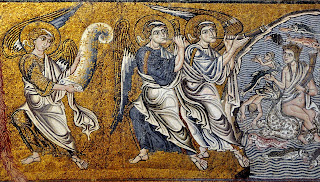The Antinomic Unity of Heaven and Hell

A fascinating excerpt from John Panteleimon Manoussakis, The Ethics of Time: A Phenomenology and Hermeneutics of Change (Bloomsbury Press, 2017). The antinomic unity of heaven and hell was first introduced by Origen in one of his early writings, the Exhortation to Martyrdom , and was further developed in his refutation of Celsus. In the Exhortation to Martyrdom we meet the idea of the self ’s division (διαίρεσις) and separation (χωρισμός) from itself, or at least from a part of itself. Already at this nascent stage, this theory is invoking the scriptural passage of 1 Cor. 3:10–15. Later in the same work the idea of the coincidence of salvation and condemnation is articulated with the aid of a double metaphor: that of the word of God as a sword that cuts through the self ’s interiority (based on Heb. 4:12), and that of God as a purifying fi re (attested in a number of scriptural passages). These two metaphors are then combined in order to support the theory that, at the end of time
